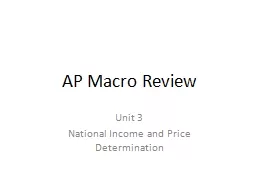

Unit 3 National Income and Price Determination 1 The aggregate demand curve is downward sloping because of The realbalances effect The interest rate effect The substitute effect The crowding out effect ID: 578953
Download Presentation The PPT/PDF document "AP Macro Review" is the property of its rightful owner. Permission is granted to download and print the materials on this web site for personal, non-commercial use only, and to display it on your personal computer provided you do not modify the materials and that you retain all copyright notices contained in the materials. By downloading content from our website, you accept the terms of this agreement.
Slide1
AP Macro Review
Unit 3
National Income and Price DeterminationSlide2
1. The aggregate demand curve is downward sloping because of:
The real-balances effect
The interest rate effect
The substitute effect
The crowding out effect
Both A and BSlide3
2. All of the following will cause the aggregate demand curve to shift EXCEPT:
Change in consumer income
Change in price level
A decrease in government spending
An increase in net exports
An increase in net importsSlide4
3. Which of the following factors will shift the aggregate supply curve to the right?
An increase in productivity
Increased wages for workers
An increase in government regulations
Consumer income increases
None of the aboveSlide5
4. Other things being equal, a shift of the aggregate supply curve to the left involves all of the following EXCEPT:
An increase in government regulation
A decrease in workers’ wages
A decrease in the labor force
An increase in taxes
A decrease in productivitySlide6
5. The interest rate effect suggests:
A decrease in the money supply will increase interest rates
An increase in the price level will decrease the demand for money
An increase in the price level will lead consumers and businesses to borrow more money, which increases the interest rate
A decrease in the price level will lead consumers and businesses to borrow more money, which increases the interest rate
An increase in the price level will lead consumers and businesses to borrow less money, which increases the interest rateSlide7
6. Imagine that investment increases by $10 billion and the MPC is 0.8. The aggregate demand curve will shift:
Leftward by $30 billion at each price level
Rightward by $5 billion at each price level
Rightward by $80 billion at each price level
Leftward by $18 billion at each price level
Rightward by $50 billion at each price levelSlide8
7. Macroeconomic equilibrium occurs when:
Full-employment GDP exceeds equilibrium GDP
Equilibrium GDP exceeds full-employment GDP
The quantity of real output demanded is equal to the quantity of real output supplied
There is a sustained falling price level
GDP falls for a consecutive six monthsSlide9
8. When the full-employment level exceeds the level of aggregate expenditures, which of the following most likely develops?
An inflationary gap
A recessionary gap
Hyperinflation
Stagflation
recessionSlide10
9. The full-employment equilibrium occurs at the intersection of:
The aggregate demand curve and the short-run and long-run aggregate supply curves
The Phillips curve and the aggregate demand curve
The aggregate demand curve and the long-run aggregate supply curve
The aggregate demand curve and the short-run aggregate supply curve
None of the aboveSlide11
10. A change in spending may generate even larger or smaller changes in real GDP. This is known as the:
Crowding out effect
Velocity of money
Quantity theory of money
Multiplier effect
Marginal propensity to saveSlide12
11. The crowding out effect refers to the relationship between:
Government spending/borrowing and private investment/consumption
Full-employment and inflation
Unemployment and inflation
Government spending/borrowing and net exports/imports
None of the aboveSlide13
12. Which of the following will cause the aggregate demand curve to shift to the right?
An increase in the price level
An increase in interest rates
An increase in government spending
A decrease in government spending
A decrease in personal consumptionSlide14
13. If the MPC is 0.6, how much would the government need to spend if it desired a $25 billion increase in national income?
$2.5 billion
$50 billion
$15 billion
$5.2 billion
$10 billionSlide15
Answer Key
E
B
A
B
C
E
C
B
A
D
A
C
E